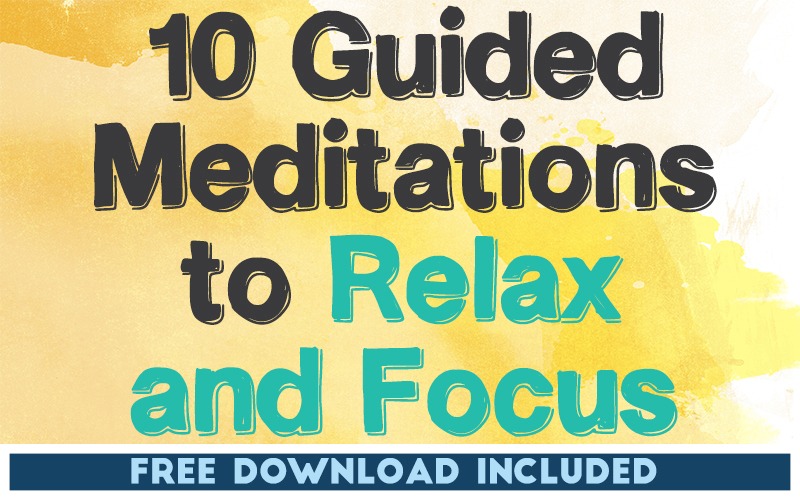
THIS POST INCLUDES:
——————————————–
1. What is a Guided Meditation
2. How to use Guided Meditations
3. 10 Guided Meditations
4. Download Free Summary of Guided Meditations
WHAT IS A GUIDED MEDITATION
You may already be familiar with the concept of meditation. Many people connect meditation with eastern philosophies such as Buddhism. They may also assume meditation is focused on the process of clearing your mind of all thoughts.
While meditation has become increasingly popular amongst the Western world, so too is our understanding of the benefits and the process of meditating. Meditation is focused less on clearing the mind but instead drawing attention to the present whether that attempting to focus your mind or not.
Guided meditation involves someone leading you through a meditation session. Guided meditation usually involves someone speaking throughout the meditation session. The speaker gives suggestions about how you can direct your thinking while you go through the meditation experience.
A lot of research has been undertaken on the biological and psychological benefits of meditation. These benefits are available across the lifespan amongst a wide variety of demographics.
Meditation has a number of reported benefits including:
- Reduce stress and anxiety
- Reduce insomnia
- Reduce high blood pressure
- Decrease pain symptoms
- Overcome substance abuse
- Improve creativity
- Improve memory
- Improve workplace productivity
- Increases positive emotion
- Assists with problem solving
- Focus on compassion and not revenge
- Assists with emotional regulation
- Improves self control
- Assist with ADHD and ADD
There are various forms of meditation. Some of the more popular types of meditation are:
- Transcendental meditation (TM) – involves repeating a mantra
- Mindfulness Meditation – involves a focus on the present
- Guided Meditation – involves a speaker providing suggestions for how to direct the meditation experience
- Mantra Meditation – involves using a syllable, word, or phrase repeated throughout the meditation
- Spiritual Meditation – focuses on moving beyond your personal experiences and focusing on the presence of joy, peace, and love
- Meditation connected with physical practice – eg. Yoga, tai chi etc
Most meditation practices have a similar goal but may use a slightly different path to achieve the same goal. For beginners, one of the most popular types of meditation is guided meditation.
Meditation may feel difficult for people who are caught up in the busyness and stresses of life. To sit still, quietly, and attempt to focus your thoughts can be a difficult experience. Having someone to guide your thoughts through a meditation session can help you reduce the feelings of overwhelm and distraction.
Guided meditations can be a great introduction to meditation. As you develop through your meditation practice, you may choose to move away from guided meditations, and instead focus on your own methods of meditation.
HOW TO USE GUIDED MEDITATIONS
Guided meditation is provided by a trained practitioner who guides you through a meditation practice using text, audio, video or a combination of various formats.
The meditation practitioner guides you through a process of mental thoughts and imagery to activate the senses of sight, sound, taste, smell and touch. Guided meditations are not informational lectures. Guided meditations are a personal connection to your experiences, feelings and emotions as you are guided through the session.
Guided meditation is an excellent method to use as a beginner to meditation. Meditation can often feel like a frustrating endeavour to beginners who feel they are constantly fighting with distracting thoughts.
Using guided meditation helps a beginner through the process of meditation by providing a series of focused instructions on how to redirect thoughts when distractions arise. Guided meditations also help to provide a central focus while you explore your thoughts and feelings through mental imagery.
Guided meditations as especially effective in helping to create a state of relaxation through developing awareness of physical sensations.
Most meditation sessions are focused on 3 primary goals:
- INTENTION: setting your intention for your meditation practice including the time and space needed for your meditation session.
- PHYSICAL: paying attention to any physical sensations you are feeling
- EMOTIONS: paying attention to the emotions that may arise during your meditation sessions.
You can start your meditation practice with a 5 minute session. This amount of time will help you develop the practice of devoting time to becoming present and finding time to dedicate to relaxation.
As you become more practiced with your meditation sessions, you can increase the time you spent on your meditation practice.
Meditation is like any other skill that you are trying to acquire – the more you practice, the easier it gets.
10 GUIDED MEDITATIONS
Below are 10 guided meditations to get you started on your journey to relaxation through meditation.
- ABC Radio National
- Audio Dharma
- Sharon Salzberg
- Fragrant Heart
- Sam Harris
- Meditation Oasis
- Mindfulness Meditation
- Tara Brach
- The Guided Meditation Site
- UCLA Mindful Awareness Research Center
These meditations can be played on your computer, phone or tablet.
FREE DOWNLOAD
SIGN UP below to receive your FREE DOWNLOAD. Once you enter your email address, you will receive access to the Free Summary of Guided Meditations.
You can also access this Evernote document which contains the same guided meditation links. You can save this note to your own Evernote. You can view the Evernote document even if you do not use Evernote.

BUILD YOUR REIKI REFERENCE MATERIALS:
Pin this image to your Pinterest board.

SHARE KNOWLEDGE & PASS IT ON:
If you’ve enjoyed this post, please share it on Facebook, Twitter, Pinterest. Thank you!
